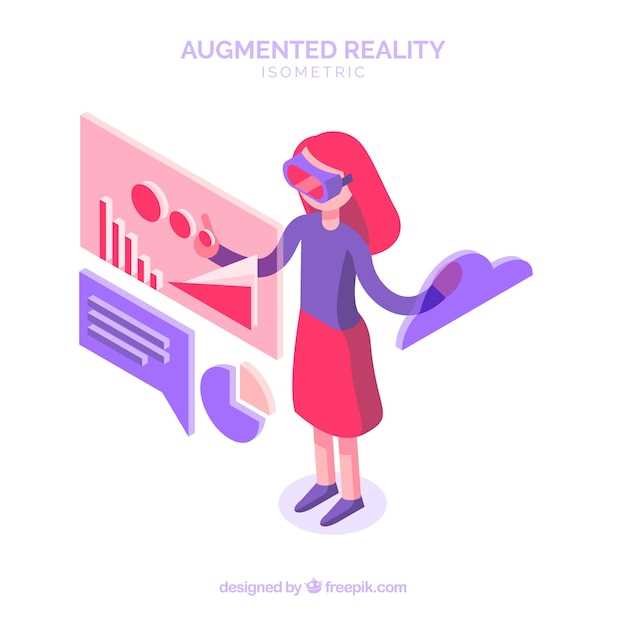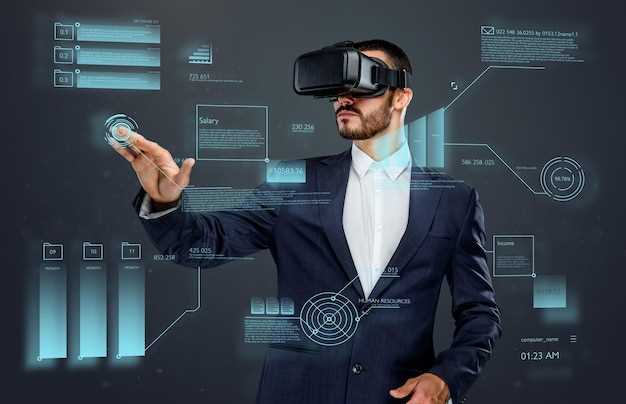
In today’s fast-paced and competitive business landscape, companies are constantly seeking innovative ways to gain a competitive edge and stay ahead of the curve. One such groundbreaking technology that is revolutionizing the way businesses operate is the integration of advanced digital enhancements in their day-to-day operations.
By incorporating cutting-edge visualizations and interactive elements into their processes, organizations are able to enhance their productivity, efficiency, and overall performance. This game-changing technology offers a new dimension of engagement and collaboration, allowing teams to work more effectively and seamlessly across various departments and locations.
The fusion of digital enhancements with traditional business practices is reshaping the corporate world, providing a unique opportunity for companies to streamline their operations, optimize their resources, and create immersive experiences for their customers and stakeholders.
Innovative Applications in Various Industries
Exploring the cutting-edge uses of augmented reality in different sectors, we uncover a multitude of creative ways in which this technology is revolutionizing traditional practices. From enhancing customer experiences in retail to streamlining complex manufacturing processes, the possibilities seem endless. Let’s delve into some of the most innovative applications of AR across a range of industries.
Retail and E-commerce

In the world of retail and e-commerce, innovative technologies are changing the way companies engage with customers and conduct transactions. The integration of augmented reality in this field has the potential to revolutionize the shopping experience, enhance product visualization, and increase customer satisfaction.
- Enhanced Product Visualization: Augmented reality allows customers to virtually try on clothing, visualize furniture in their own space, or test out cosmetic products without physically interacting with them. This immersive experience not only helps customers make more informed purchasing decisions but also increases their confidence in the products they buy.
- Interactive Shopping Experience: By incorporating augmented reality features into their mobile apps or websites, retailers can offer customers a more interactive shopping experience. From virtual fitting rooms to AR-powered product demonstrations, companies can create engaging and personalized experiences that drive customer engagement and loyalty.
- Increased Convenience: Augmented reality technology enables customers to shop from the comfort of their own homes, eliminating the need to visit physical stores. With AR-powered shopping tools, customers can easily browse through products, compare prices, and make purchases without leaving their couch, saving time and effort.
Overall, the integration of augmented reality in retail and e-commerce is reshaping the way companies market products, interact with customers, and drive sales. By leveraging this innovative technology, businesses can stay ahead of the competition, attract new customers, and enhance the overall shopping experience for consumers.
Manufacturing and Maintenance

In the sphere of production and upkeep, augmented reality technology is revolutionizing the way tasks are carried out. By overlaying digital information onto the physical environment, organizations can enhance efficiency, accuracy, and safety in their manufacturing processes and maintenance procedures.
| Benefits of Augmented Reality in Manufacturing and Maintenance |
|---|
| 1. Enhanced Visualization |
| 2. Improved Training |
| 3. Real-time Data Monitoring |
| 4. Error Reduction |
| 5. Remote Assistance |
These advancements in augmented reality are reshaping the landscape of manufacturing and maintenance, providing companies with innovative solutions to streamline operations and optimize performance. The seamless integration of digital overlays into physical tasks is propelling businesses towards greater productivity and success in the modern era.
Future Trends and Opportunities
In the upcoming years, the landscape of augmented reality is set to evolve drastically, providing exciting possibilities for businesses across various industries. From enhanced customer experiences to streamlined operations, the future of AR presents a myriad of opportunities for growth and innovation.
One of the emerging trends in AR is the integration of artificial intelligence, allowing for more personalized and interactive experiences. This technology opens doors for businesses to tailor their AR applications to individual users, creating a more engaging and immersive environment.
Additionally, the rise of wearable AR devices is poised to revolutionize how businesses interact with their customers and employees. These devices enable hands-free operation and real-time information display, offering a seamless and intuitive user experience.
Furthermore, the expansion of AR into new industries such as healthcare, education, and manufacturing presents unique opportunities for organizations to optimize their processes and enhance productivity. By leveraging AR technologies, businesses can improve training programs, reduce errors, and increase overall efficiency.
As businesses continue to explore the possibilities of augmented reality, the future holds endless opportunities for growth and innovation. By staying ahead of the curve and embracing the latest trends, organizations can position themselves for success in an increasingly competitive market.
Emerging AR Technologies

In the realm of cutting-edge innovations and advancements, there is a growing interest in the field of emerging AR technologies. These revolutionary advancements are shaping the future landscape of technology and changing the way businesses operate and engage with their customers. In this section, we will explore some of the most exciting and promising AR technologies that are set to disrupt various industries.
| 1. Spatial Mapping | Spatial mapping technology allows for the creation of detailed digital maps of physical spaces, enabling users to interact with augmented objects in real-world environments. |
| 2. Object Recognition | Object recognition technology uses computer vision algorithms to identify and track physical objects, enhancing user experiences by overlaying relevant information or digital content. |
| 3. Gesture Recognition | Gesture recognition technology enables users to control AR interfaces and interact with digital content using hand gestures, providing a more intuitive and immersive experience. |
These emerging AR technologies represent the next frontier in digital innovation, offering limitless possibilities for businesses to create unique and compelling experiences for their customers. By harnessing the power of these technologies, companies can stay ahead of the curve and differentiate themselves in a competitive market.
Investment Potential
The financial outlook for opportunities in this innovative technology space is promising. Businesses that have begun to explore this cutting-edge field have witnessed significant potential for growth and profitability. Investors are increasingly attracted to the possibilities that augmented reality presents, recognizing it as a lucrative avenue for investment.
With a multitude of industries integrating augmented reality into their operations, the investment potential in this area is diverse and expansive. From healthcare and education to retail and entertainment, companies across a wide spectrum are tapping into the benefits of this advanced technology. As a result, the market for augmented reality investments is rapidly expanding, creating a wealth of opportunities for investors seeking to capitalize on this growing trend.
Moreover, as augmented reality continues to evolve and become more sophisticated, the potential returns on investment are expected to rise. Businesses that effectively implement augmented reality solutions stand to gain a competitive edge in their respective markets, driving increased revenue and market share. This upward trajectory further solidifies augmented reality’s status as a promising investment prospect with long-term viability.
AR Business Use Cases
Exploring the various applications and instances where augmented reality technology is being utilized within the corporate environment can shed light on the immense potential and versatility of this innovative tool. From enhancing customer experiences to optimizing employee training, AR is revolutionizing the way businesses operate and interact with their stakeholders.
- Enhanced Marketing Campaigns
- Immersive Product Demonstrations
- Remote Collaboration and Communication
- Improved Training and Onboarding Processes
- Enhanced Data Visualization and Analytics
Video:
Augmented Reality for Everyone – Full Course
Augmented Reality for Everyone – Full Course by freeCodeCamp.org 542,341 views 2 years ago 11 hours, 39 minutes
FAQ:
How can augmented reality benefit businesses?
Augmented reality can benefit businesses by enhancing customer experiences, improving employee training, increasing productivity, reducing errors, and driving sales through immersive and interactive experiences.
What industries can benefit most from implementing augmented reality technology?
Various industries such as retail, healthcare, real estate, manufacturing, and education can benefit most from implementing augmented reality technology. These industries can leverage AR to enhance customer engagement, improve operational efficiency, and offer innovative solutions.
Is augmented reality only beneficial for large corporations, or can small businesses also take advantage of this technology?
Augmented reality is not limited to large corporations. Small businesses can also take advantage of this technology to differentiate themselves from competitors, improve customer engagement, and streamline processes. There are cost-effective AR solutions available for businesses of all sizes.
How can businesses integrate augmented reality into their existing operations?
Businesses can integrate augmented reality into their existing operations by developing custom AR applications, using AR-enabled devices such as smartphones or smart glasses, partnering with AR development companies, and providing training to employees on how to use AR technology effectively.
What are some examples of successful businesses that have implemented augmented reality technology?
Some examples of successful businesses that have implemented augmented reality technology include IKEA, Sephora, Volkswagen, and L’Oreal. These companies have used AR to enhance customer experiences, drive sales, and stay ahead of the competition in their respective industries.
How can augmented reality benefit businesses?
Augmented reality can benefit businesses in a variety of ways, such as enhancing customer experiences, improving employee training, increasing efficiency in operations, and driving sales and marketing efforts. By integrating AR technology into their strategies, businesses can stay ahead of the competition and provide innovative solutions to their customers.